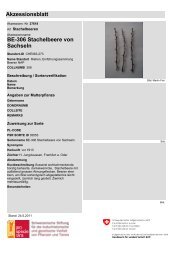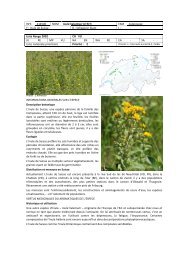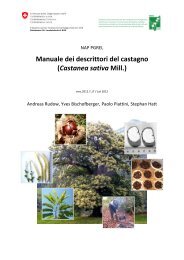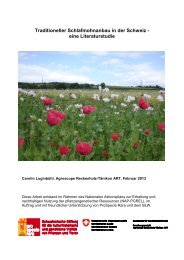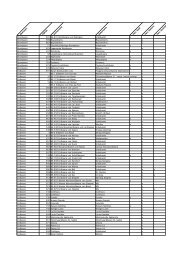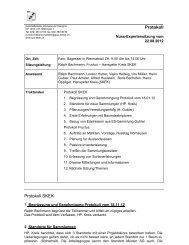Schlussbericht Crop Wild Relative
Schlussbericht Crop Wild Relative
Schlussbericht Crop Wild Relative
- TAGS
- schlussbericht
- crop
- wild
- relative
- bdn.ch
Erfolgreiche ePaper selbst erstellen
Machen Sie aus Ihren PDF Publikationen ein blätterbares Flipbook mit unserer einzigartigen Google optimierten e-Paper Software.
1<br />
2<br />
<strong>Crop</strong> <strong>Wild</strong> <strong>Relative</strong> Case Study 1<br />
Ecotypic exploration and characterization trials to promote<br />
conservation of Arnica montana L. in Northern Europe<br />
Å. Asdal 1 , J. Labokas 2 , K. Olsson 3 , J. Radušienė 2 and K.W. Bladh 4<br />
1Norwegian <strong>Crop</strong> Research Institute, Norway, 2Institute of Botany, Lithuania 3Svaløf Weibull AB, Sweden 4Nordic Genebank, Sweden<br />
Photography K. Olsson and B. Galambosi Maps J. Radušienė and Den Virtuella Floran, Naturhistoriska riksmuseet, Sweden<br />
Medicinal uses: historical and current<br />
Taxonomy and biology<br />
Arnica montana L. is divided into two subspecies; ssp. montana<br />
grows in Scandinavia and Central Europe, while ssp. atlantica is<br />
found in the south of France, Spain and Portugal. The geographical<br />
distribution of A. montana in the Nordic countries is shown in<br />
fig. 1. Arnica is common in the western part of Denmark and in<br />
the south-western part of Norway. It is also found in Southern<br />
Sweden, where it is richest in Småland, but due to loss of its habitat<br />
it has declined during the last decades. Lithuania is on the<br />
north-eastern border of the distribution in the Baltic region (Figure<br />
2)<br />
Ecotypic variation in Lithuania<br />
In its main distribution area, Central and Western Europe, Arnica<br />
montana is a species of meadows, pastures and heaths, mainly<br />
in mountains. In Lithuania, on the north-eastern border of its distributional<br />
range, the species evolved into a lowland forest ecotype<br />
which occurs in light and dry pinewoods in the southern and<br />
south-eastern parts of the country. The former, mountainmeadow<br />
ecotype, occurs only in one location, occupying less<br />
than 1 hectare of wet grassland near Medininkai village in the<br />
Vilnius district. This ecotype develops more vigorously compared<br />
to the forest one. this ecotypic differentiation is not reported<br />
from the central area of its distribution and may be attributed to<br />
an increased ecological adaptability of the species as a consequence<br />
of its occurrence on the border of its distributional range.<br />
A. montana L. has been applied for centuries in folk medicine to treat<br />
swelling, soreness and bruising. Active components in Arnica are sesquiterpene<br />
lactones, helenalin and dihydrohelenalin and their short esters<br />
(Douglas et al., 2004). An estimated 50,000 kg of dried flowers are used<br />
annually in Europe. This is equivalent to 250,000-300,000 kg of fresh flowers.<br />
In addition, hundreds of kilos of dried roots are utilized each year (Lange,<br />
1998). Arnica is mainly harvested from the wild. The main sources of Arnica<br />
for medicinal use are the Balkan countries, Spain and Switzerland.<br />
The demand for A. montana has remained consistently high in face of<br />
continuing declines in availability in the wild.<br />
PGR Forum<br />
European <strong>Crop</strong> <strong>Wild</strong> <strong>Relative</strong> Diversity Assessment<br />
and Conservation Forum



